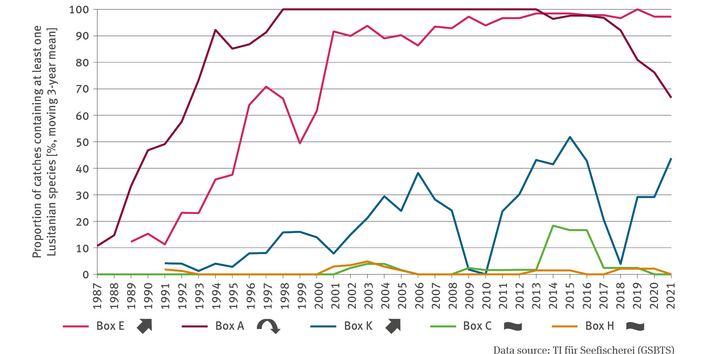Rising water temperatures (cf. Indicator KM-I-1), the changed regimes of sea currents as well as rising CO2 concentrations in sea water, change the living conditions for all marine organisms. It is worth remembering that water masses in the North Sea do not warm up in the direction of north to south. In fact, the warming process takes place in complex spatial patterns. In the North Sea it has been observed that the stocks of psychrophilic (cold-loving) fish, molluscs and crustaceans have a tendency to move to cooler zones as warming increases. Their organism requires a specific range of temperatures, which is no longer available to them in a warming habitat. Besides, they follow the plants, plankton and other marine organisms they feed on and which – like the fish themselves – prefer water at colder temperatures. At the same time, new species emanating from more southerly seas have encroached on the North Sea.
The brackish water of the Baltic Sea, with its mixture of freshwater and seawater, has given rise to unstable ecological equilibria. The high variability of these environmental conditions provides only few, very tolerant fish species with adequate conditions for living and reproduction. In view of the higher tolerance of the species occurring there, it is to be expected that the consequences of climate change in the Baltic Sea will have less pronounced impacts on species shift than in the North Sea. Nevertheless, changes have been observed already to the productivity of fish stocks in the Baltic Sea (cf. Indicator FI-I-2).
Changes in the distribution of fish stocks and in species composition confront marine fisheries with new challenges. In this light, the spatial shift of North Sea fish populations towards cooler zones may entail economic losses to the fishery operators concerned, if new ranges of well-known species become harder to reach thus requiring distinctly greater expenditure. It is hard to predict with any certainty to what extent such economic and ecological effects might be offset against the distribution
and abundance of other species. At any rate, under current circumstances, it would not yet be worthwhile for fisheries to target these alternative species.
An important foundation for future adaptation of fishery management is the accurate observation of the spatial shift in fish stocks and the observation of changes in the species communities. Under the ‘German Small-scale Bottom Trawl Survey’ (GSBTS), standardised catches are carried out every year in designated areas of the North Sea. The objective is to assess the natural variability of fishing yields for various species of fish and to record medium to long-term changes in the composition of fish communities.
The analysis of catch records relating to more than the past 30 years in five research areas within the German Bight, reveals that more and more frequently thermophilic south-European (lusitanian) species have been identified in catches. Typical representatives of this group of species are, for instance, the tub gurnet (Chelidonichthys lucerna), the red mullet (Mullus surmuletus), the yellow sole (Buglossidium luteum) and the Mediterranean scaldfish (Arnoglossus laterna) as well as the anchovy (Engraulis encrasicolus) and the sardine (Sardina pilchardus). In the most southerly fishing zones nearest the German coast (Box A and Box E), every catch – landed over the past decades – turned up at least one of these species, whereas in the late 1980s such catches would have been rare. At the turn of the millennium, Box A already contained some thermophilic species every time.
However, the frequency of such catches decreased in recent years, and distinctly so after 2017. In those areas, the catch frequency relating to the lusitanian species – as represented in the indicator – declined during the period of 2017 to 2021 from almost 100 % to 67 % in 2020. This trend reversal is attributed to the two small flatfish species of yellow sole (Buglossidium luteum) and in particular the Mediterranean scaldfish (Arnoglossus laterna) occurring more rarely. The underlying reasons are currently being researched.
Beginning in the mid-1990s, a little further north – approximately in the latitude of Denmark’s Esbjerg (Box K) – representatives of the lusitanian species appeared, and this subsequently happened with medium frequency, albeit not continuously. Likewise, there have been catches further north, in the eastern North Sea (Box C) sporadically, which suggest a potential distribution occurring also in these areas, that goes hand-in-hand with increasing temperatures.
At the same time as the encroachment of southern European species, a decline in psychrophilic species has been observed. As a case in point, the codfish (Gadus morhua) has almost completely disappeared from the southern North Sea which represents the southern edge of the distribution range of codfish. This is not just a consequence of intensive fishing, but – due to the detrimental effect of the seas warming in these latitudes – also of the basic food source of this species of fish and its metabolism.
The increasing warming effect appears to play a major role in the spatial shift of fish stocks. However, apart from climate change, there are other factors, such as commercial fisheries, that are responsible for changes in the spatial distribution of fish stocks. Mild winters have enabled some southern fish species to survive winters and reproduce in the North Sea.


